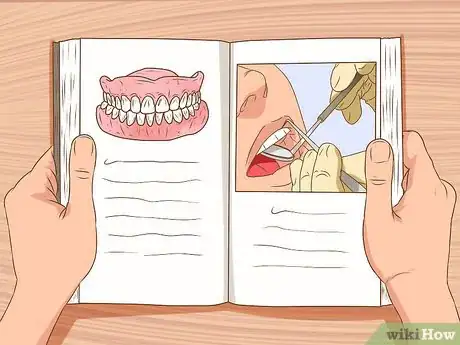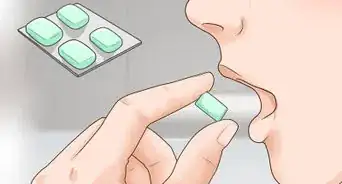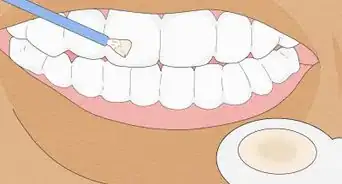This article was co-authored by Tu Anh Vu, DMD. Dr. Tu Anh Vu is a board certified dentist who runs her private practice, Tu's Dental, in Brooklyn, New York. Dr. Vu helps adults and kids of all ages get over their anxiety with dental phobia. Dr. Vu has conducted research related to finding the cure for Kaposi Sarcoma cancer and has presented her research at the Hinman Meeting in Memphis. She received her undergraduate degree from Bryn Mawr College and a DMD from the University of Pennsylvania School of Dental Medicine.
There are 13 references cited in this article, which can be found at the bottom of the page.
This article has been viewed 37,691 times.
If you get a little nervous about going to the dentist, you're not alone—in an article published in Medical Principles and Practice, researchers stated that around 36% of people have some dental anxiety.[1] However, if you have a cavity, it's important to get it filled to keep it from getting worse. Keep reading for tips that can help you feel prepared and relaxed the next time you need a filling!
Steps
Making Sure You're Prepared for Your Appointment
-
1Bring headphones and listen to an audiobook or music. Listening to music or a funny audiobook before and while you’re getting a cavity filled can help you relax. Consider what best relaxes or distracts you, whether it’s loud, heavy music or something more calming. Make a playlist and show up to your appointment with a good set of headphones that’ll drown out any sounds from the dentist’s tools.[2]
- Talk to your dentist in advance to make sure wearing headphones, especially a bulkier set, won’t interfere with their work.
- Make sure that the volume is not too high so that you will still be able to hear the dentist’s instructions for you.
-
2Don’t show up too early. Showing up more than five or ten minutes early might make you more nervous. While it’s always good to show up on time or a little early to appointments, you don’t want to have to sit in the waiting room for a while anticipating the procedure. If you do arrive to the office too early, wait in your car or outside until a few minutes before your appointment, since waiting rooms themselves can be a source of anxiety.[3]
- The sound of the drill turbine can provoke anxiety in some people, so try to avoid hearing it if possible.
Advertisement -
3Empty your bladder and take any recommended dietary precautions. Talk to your dentist in advance about whether or not you can eat before the procedure. If you’ve already made arrangements for a general anesthetic, or a sedative that makes you unconscious, you may not be able to eat after midnight the night before.[4] In addition, go to the bathroom before your appointment. It’s a lot easier to relax while sitting in the dentist’s chair for a while if you don’t have to use the restroom!
Helping a Child Relax During a Filling
-
1See a pediatric dentist. Kids are not simply smaller versions of adults, so it’s important not to take a child to an adult dentist. Not only are pediatric dentists specially trained in kids’ oral health, they are more familiar with methods that help kids relax in the dentist’s chair. They are also more likely to have a kid-friendly disposition, better word choices, and more patience with little ones’ fears.[5]
- Pediatric dentists are also more experienced at calming down children and their offices are decorated in a way that is meant to create a fun place for children.
-
2Consider whether or not a parent should be in the room. Depending on a child’s age and personality, it may or may not be appropriate for a parent to be present during a filling. Additionally, some dentist offices prefer one or the other, so if you’re a concerned parent, consult with your pediatric dentist. If you’re more comfortable with one or the other, you can do some research and find a dentist whose practices match your preferences[6]
- If you do stay in the room during the filling, stay in a place where the child knows you’re present but can’t see your face. They’ll respond to even subtle faces you might make and could become anxious or move around. Keep a calm, pleasant expression on your face and say reassuring things.
- If you aren’t in the room, stay in the waiting room. Don’t leave to run errands in case you are needed for anything.
- If you’re not in the room and are worried, the office’s staff will keep you informed about what’s going on with the procedure. Ask them for an update if you’re concerned.
-
3Choose words carefully and consider tone of voice. Pediatric dentists are typically very sensitive about the words and tone of voice they use with a young child, and parents should follow suit. It’s important to explain things in terms that are appropriate and make sense for the child. Speaking in a calm, controlled, and positive tone of voice is just as essential as using kid-friendly words. [7]
- Try explaining that one of their teeth has a cold or is sick, and that the dentist is going to make it feel better.
- Use positive reinforcement to remind a young child how great of a job they’re doing, that you’re very proud of them, and that going to the dentist is part of growing up that they should take pride in. Promising a reward after may also help, so you might remind your child of this if you are allowed to be in the room during the procedure.
-
4Consider nitrous oxide as an anesthetic. Dentists are using nitrous oxide as an anesthetic for children more frequently in recent years. There are no harmful effects or side effects associated with nitrous oxide, regardless of age.[8] This method of sedation can be especially beneficial for children who are extremely afraid of needles or would otherwise require restraint, as it’s much safer for kids than general anesthesia.[9]
Consulting with Your Dentist
-
1Choose the right dentist. Do some research before going with a dentist to fill your cavity, especially if you or your child don’t already see one regularly. Find a dentist by asking friends or family for referrals of a dentist they trust, or you could read reviews online to see what other people think about dentists in your area.[10] In addition, call offices to shop around for a dentist who’s not only highly skilled, but deeply sensitive and empathetic.[11]
- If you have a dentist you can trust, it will go a long way toward alleviating the anxiety you feel.[12]
- Verify their qualifications by calling the office and asking about their degrees and licensing.
- Some dentists hang televisions or posters from ceilings, play music, or use other means to distract patients during procedures.[13] If the TV is 3D capable, then you can wear 3D glasses during the procedure.
- If you or your child experiences significant fear of the dentist, consider calling offices and asking what distraction methods they use.
-
2Ask your dentist about anesthetic and sedative options. Typically, an oral gel is first administered to the surrounding gum tissue. After a minute or so, a needle injects Novocain to numb the area completely. A sensitive dentist will time these steps so that you won’t feel anything. However, since some people don’t respond to Novocain or Mepivacaine or are severely afraid of needles, you should discuss the sedative process, cost range and coverage, and available options.[14]
- General anesthetic is rarely used for fillings, but is sometimes administered in cases of severe fear or anxious of dental procedures.
- You’re not able to drive after general anesthesia, so make sure to set up a ride if necessary. Also, take into account the side effects, which usually include dizziness.
- Nitrous oxide, or laughing gas, is a common dental sedative. Unlike general anesthesia, you’re allowed to eat prior to being administered nitrous oxide
- Oral sedatives, or sleeping pills like Halcion and Valium, are becoming more commonly administered in dental-phobic patients. If your dentist is trained to offer these medications, make sure you understand when and how much to take, and set up rides to and from the appointment.[15]
-
3Learn about fillings from your dentist and by researching. Understanding why ignoring a cavity can makes things much worse can help you relax during a filling. Fillings are important because they get rid of decay and act like a normal tooth, allowing you to continue to chew and talk. They also protect the pulp against external factors, so having it done as fast as possible can save you from expensive root canal treatments. Ignoring a cavity and not getting a tooth filled can lead to much more significant dental work, like crowns, root canals, or tooth extractions.[16]
- Knowing that a filling isn’t the most intense dental procedure to fix cavities can help you face your fear and relax. Even if a cavity does require a crown or root canal, these are tried and true procedures that will help you feel better in the long run.
- If you need to have a big procedure done, try making an appointment for a routine cleaning first. That way, you can get to know your dentist and build a relationship with them.[17]
- Know that lots of people are afraid of the dentist, but it’s important to get your teeth taken care of in order to maintain your overall health. Ignoring a cavity can lead to infections that can make you very sick, representing a threatening danger for your overall health.
-
4Have your dentist explain which kind of filling is best. Fillings are either composite, which are made of plastic and glass, or amalgam, which is made of silver and other metals. Amalgam fillings have been used for almost two hundred years, and while composite ones are newer, they’re becoming more and more advanced as time goes on.
- Amalgam fillings are stronger, and usually the best option for kids.
- Composite fillings are usually more expensive and don’t last as long, but are the same color as natural teeth.[18] You will need to get these checked annually to ensure that the margins are intact and there is nothing getting into the area beneath them.
- You might read about how amalgam fillings contain a small amount of mercury, but you shouldn’t be worried. When it’s combined with other metals, mercury isn’t harmful unless you have an allergy.
- Amalgam fillings have also been around a long time, so there’s plenty of evidence to show that there are no long-term harmful effects.[19]
-
5Ask your dentist to explain the procedure and show you the tools. While some people express fear of seeing and hearing dental tools, others are more concerned about what they don’t know or see firsthand. If you typically experience a fear of the unknown or fear of not having control, consider asking your dentist to explain the procedure in detail and tell you about how each dental tool works.[20]
- Do your best to know what you’re afraid of and why. Know yourself and if you’re generally more or less comfortable when you know all the details about something scary.
- In addition, ask your dentist about any maintenance for your fillings. Typically, every 6 months when you come in for your filling, your dentist will give you an X-ray to make sure the filling isn't loose or broken, and that there isn't any decay recurring under the filling.[21]
Expert Q&A
-
QuestionHow would you recommend calming someone down who's hesitant about going to the dentist?
 Tu Anh Vu, DMDDr. Tu Anh Vu is a board certified dentist who runs her private practice, Tu's Dental, in Brooklyn, New York. Dr. Vu helps adults and kids of all ages get over their anxiety with dental phobia. Dr. Vu has conducted research related to finding the cure for Kaposi Sarcoma cancer and has presented her research at the Hinman Meeting in Memphis. She received her undergraduate degree from Bryn Mawr College and a DMD from the University of Pennsylvania School of Dental Medicine.
Tu Anh Vu, DMDDr. Tu Anh Vu is a board certified dentist who runs her private practice, Tu's Dental, in Brooklyn, New York. Dr. Vu helps adults and kids of all ages get over their anxiety with dental phobia. Dr. Vu has conducted research related to finding the cure for Kaposi Sarcoma cancer and has presented her research at the Hinman Meeting in Memphis. She received her undergraduate degree from Bryn Mawr College and a DMD from the University of Pennsylvania School of Dental Medicine.
Board Certified Dentist The most important thing is to find the right dentist for you. Read reviews and ask for recommendations from family and friends, then build a relationship with that dentist. Get to know them by going to a cleaning before you have any big procedures done.
The most important thing is to find the right dentist for you. Read reviews and ask for recommendations from family and friends, then build a relationship with that dentist. Get to know them by going to a cleaning before you have any big procedures done.
References
- ↑ https://www.ncbi.nlm.nih.gov/pmc/articles/PMC5586885/
- ↑ http://www.health.harvard.edu/blog/dental-fear-our-readers-suggest-coping-techniques-20100825327
- ↑ http://www.health.harvard.edu/blog/dental-fear-our-readers-suggest-coping-techniques-20100825327
- ↑ http://www.mouthhealthy.org/en/az-topics/a/anesthesia-and-sedation
- ↑ http://www.aapd.org/assets/1/7/fastfacts.pdf
- ↑ http://www.aapd.org/assets/1/7/fastfacts.pdf
- ↑ http://www.aapd.org/assets/1/7/fastfacts.pdf
- ↑ http://parenting.blogs.nytimes.com/2013/10/31/filling-cavities-can-be-a-laugh-but-dentists-still-suggest-limiting-gummies-at-halloween/?_r=0
- ↑ http://www.aapd.org/assets/1/7/fastfacts.pdf
- ↑ Tu Anh Vu, DMD. Dentist. Personal interview. 7 May 2020.
- ↑ http://www.dentalfearcentral.org/fears/needle-phobia/
- ↑ Tu Anh Vu, DMD. Dentist. Personal interview. 7 May 2020.
- ↑ http://www.health.harvard.edu/blog/dental-fear-our-readers-suggest-coping-techniques-20100825327
- ↑ http://www.mouthhealthy.org/en/az-topics/a/anesthesia-and-sedation
- ↑ http://www.nbcnews.com/id/5446489/ns/health-special_reports/t/pop-some-pills-sleep-through-your-dental-visit/#.V_LkYCgrLb0
- ↑ http://www.mayoclinic.org/diseases-conditions/cavities/basics/treatment/con-20030076
- ↑ Tu Anh Vu, DMD. Dentist. Personal interview. 7 May 2020.
- ↑ http://www.dentalfearcentral.org/faq/fillings/
- ↑ http://www.ada.org/en/about-the-ada/ada-positions-policies-and-statements/statement-on-dental-amalgam
- ↑ http://www.dentalfearcentral.org/faq/fillings/
- ↑ Tu Anh Vu, DMD. Dentist. Personal interview. 7 May 2020.
About This Article
To help yourself relax while getting a filling, consider bringing headphones so you can listen to some calming music or an audiobook while you wait. If you plan to wear headphones during the procedure, ask your dentist if that’s okay. Try not to arrive more than 5-10 minutes before your appointment time, since waiting can make you feel more nervous. To make yourself as comfortable as possible, use the restroom before your procedure and have something to eat if your dentist says you can. Before the filling, ask your dentist for detailed information about what will happen and how you can prepare. If you’re really nervous, you can ask them about sedation options to help you relax. Read on for more advice from our Dental Health co-author, including how to calm a child during a filling!








































































Medical Disclaimer
The content of this article is not intended to be a substitute for professional medical advice, examination, diagnosis, or treatment. You should always contact your doctor or other qualified healthcare professional before starting, changing, or stopping any kind of health treatment.
Read More...